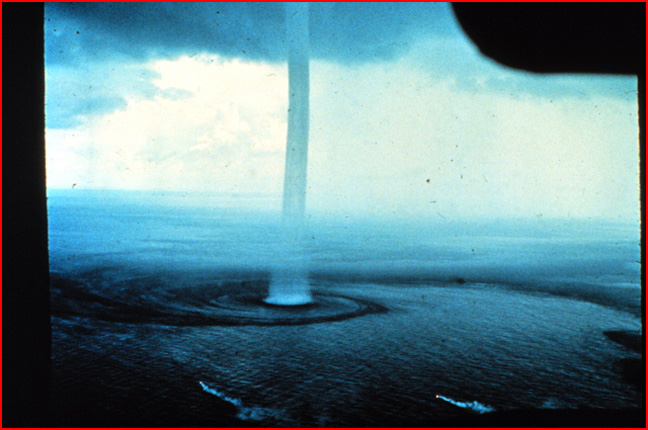|
|
||
 Credit: Historic NWS Collection, Dr. Joseph Golden, NOAA |
||
|
pic of the day Links:
Society for
|
Oct
29, 2004 Because the Earth is a small charged body moving in a large cell of plasma, explanations of all physical phenomena in, on, and near the Earth must take the electrical behavior of plasma into account. The waterspout shows us once again that plasma behavior can take many different forms. There are two types of waterspout; one type is simply a tornado over water. The other (true waterspout) is less powerful than a tornado. It forms in a different way and often in a different season. It dissipates quickly if it happens to move over land. Waterspouts occur in oceans or large lakes. They are common in the Great Lakes in months when the water is warmest--August, September, and October. They are most likely to occur when the water is warm, the air is cold and moist, and the winds are light. (They are predictable enough that the weather service issues waterspout warnings when conditions are right for their formation.) First a circular white spot surrounded by an irregular dark area forms on the water's surface. Next a pattern of light and dark bands spiral outwards. Then a dense, swirling ring of spray, called a cascade, appears around the dark spot and rises toward the clouds. When it connects to the clouds, the waterspout begins to move with the clouds. When the waterspout is mature, it can be several hundred feet high. It often creates a visible wake and a wave train as it moves (see photo above). Russian plasma physicist V. A. Rantsev-Kartinov studied waterspouts from a plasma point of view. He came to understand the waterspout as a long-lasting discharge current between the plasma networks of the ocean surface (or lake surface) and the electrical charge of the clouds above. Every world in the solar system is a charged body orbiting in a plasma. On Earth, there are many ways that the plasma interactions between Earth and space show up -- auroras, lightning, sprites and elves, tornados, hurricanes, waterspouts and dust devils, geomagnetic storms. On other worlds, different modes of electrical interaction are seen -- giant dust devils on Mars, ion "rains" on Europa, the plasma discharges of Io, the coma and tails of comets, the spokes of Saturn's rings, the complex magnetospheres of Earth and the giant planets. The solar system we see today is much more electrically active than what we imagined it would be 50 years ago, before the first satellite was launched. It would be easier to understand if we paid closer attention to what we've learned of plasma behavior in the lab, and to the interactions of electricity between Earth and space.
|
|
|
Copyright 2004: thunderbolts.info |
||
